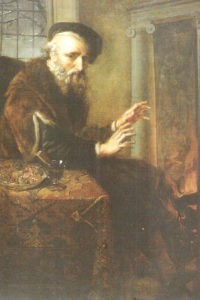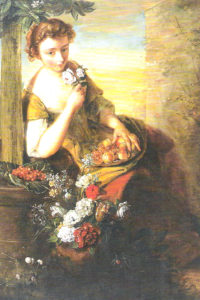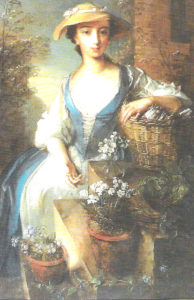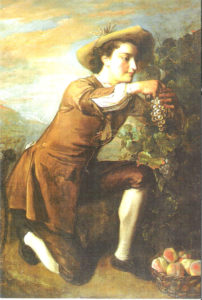The mission of the Society of Colonial Wars in the State of Maryland is to perpetuate the memory of our history and heritage through the preservation, promotion, maintenance, financial support and erection of monuments, works of art, manuscripts, museum exhibits, scholarships, and civic events focused on Maryland’s colonial past for the benefit of the public.
“Perpetuate the Memory” These words are found in the preamble of the articles of incorporation of the General Society of Colonial Wars. They are the cornerstone for why this society exists: to perpetuate the memory of the American colonial period. In order to perpetuate that memory we must preserve and commemorate those items that prompt memory. They may be buildings, monuments, records or the innumerable items associated with the colonial era. Should they be lost, then that is a loss of memory for future generations of all Americans. It is for this reason that the Stockbridge Fund of The Society of Colonial Wars in the State of Maryland is our financial commitment to the preservation of historic projects relating to Maryland’s colonial history.
Below is a sampling of the over 120 preservation projects supported by the Maryland Society since 1893.
1908
Cecilius Calvert Statue
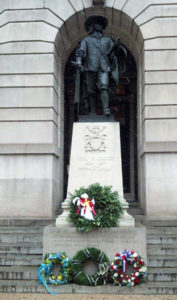 The Society has funded many historical markers in Maryland, but the most lasting contribution of the Society to the state is the Cecilius Calvert Monument created in1908. The monument is located at the St. Paul Street entrance of the Clarence Mitchell Courthouse in downtown Baltimore.
The Society has funded many historical markers in Maryland, but the most lasting contribution of the Society to the state is the Cecilius Calvert Monument created in1908. The monument is located at the St. Paul Street entrance of the Clarence Mitchell Courthouse in downtown Baltimore.
Calvert, second Lord Baltimore, was the Lord Proprietor of Maryland from
1632 to 1675 and was responsible for instituting three great principles of liberty:
freedom of religion, separation of church and state, and participation of every
freeman in the making of laws by which he is governed.
The bronze statue was sculpted by Albert Weinert and erected on November21,1908, on a marble pedestal. The front of the pedestal reads: Cecilius Calvert 1606-1675
Founder of Maryland.
The back of the pedestal reads:
CECILIUS CALVERT BARON BALTIMORE OF BALTIMORE IN THE
KINGDOM OF IRELAND. ABSOLUTE LORD AND PROPRIETARY OF THE
PROVINCE OF MARYLAND AND AVALON IN AMERICA. WHO ON
NOVEMBER 13 1633 WITH THE COOPERATION AND ASSENT OF THE
FIRST COLONISTS PROCLAIMED IN ENGLAND. AND ON MARCH 25 1634
ESTABLISHED IN THE PALATINATE OF MARYLAND FOR THE FIRST
TIME IN THE ENGLISH SPEAKING WORLD FREEDOM OF RELIGIOUS
WORSHIP ACCORDING TO ANY CHRISTIAN FORM. AND SEPARATION
OF CHURCH AND STATE.
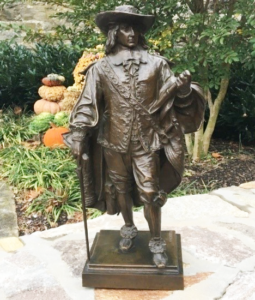
In 2017 the bronze study model (maquette) of the statue sculpted by Weinert was discovered by two Society members at an antiques show and purchased by the Society. In celebration of the Society’s 125th anniversary, a commemorative 8-inch solid bronze replica of the original 29-inch maquette was made for purchase by Society members.
1926
Sir Robert Eden’s Grave
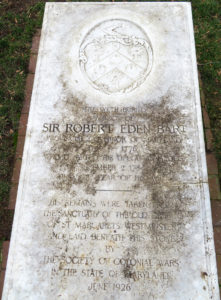
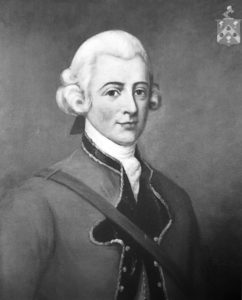
Eden, the last colonial governor for Maryland, was an extremely popular figure in Annapolis society who returned to Annapolis after the war and lived with his friend Upton Scott on Shipwright Street. He died in 1784 in Annapolis and was buried at Winchester Parish (now St. Margaret’s). In 1926 his remains were located and re-interred at St. Anne’s with the approval of Eden’s descendants and with funding by the Society.
1937
Charles Carroll, Barrister Commemorative Tablet
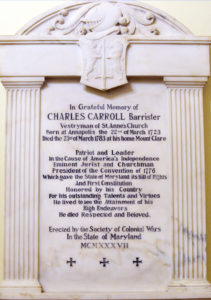
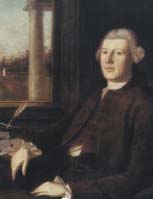
In the fall of 1776, the Maryland Ninth Convention met in Annapolis and prepared and adopted the first constitution for the new state of Maryland. This tablet at St. Anne’s Church commemorates Carroll’s leadership.
1986
Mount Clare
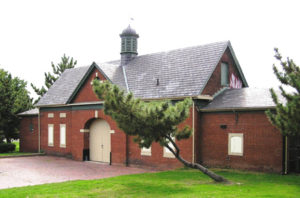
Located in Baltimore, it is the home and grounds of Charles Carroll, Barrister. It serves as a museum of colonial Maryland furniture, books and other relics, including a stamp from the infamous Stamp Act. The grant supported the restoration of the stables.
1988
St. Mary’s City Militia
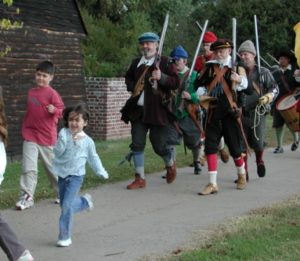
The militia serves as re-enactors in Maryland’s original settlement and capital. The grant was to construct a replica cannon for the militia.
1991
Preservation Maryland
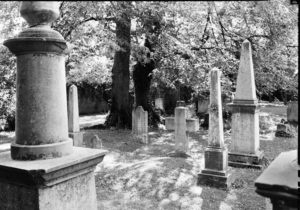
The Society provided funds to help restore the Wye House graveyard located in Talbot County on the Eastern Shore. It is the family burial ground for the Lloyd family and other patriot families.
1993
Historic St. Mary’s City Foundation
A grant was awarded to develop interpretative programs to introduce students to colonial law and how the courts conducted Maryland’s government and its issues. It also honors Philip Calvert’s contributions to Maryland. As keeper of the Maryland records, he insured the continuation of Maryland’s existence.
1998
Belair Mansion
Built in 1745, Belair was the home of a proprietary Maryland governor, Samuel Ogle, and later his son, Benjamin Ogle, elected governor of the State of Maryland. It is also home to the four Philip Mercier paintings, Four Seasons. Mercier’s patron was Frederick, Prince of Wales, a close confidant of the 5th Lord Baltimore, who gave the paintings to Samuel Ogle The grant funded the restoration of the paintings.
2001/2
Frame for Portrait of George Calvert

![GeorgeCalvert[1]](http://www.scwmd.org/wp-content/uploads/2020/03/GeorgeCalvert1-199x300.jpg)
A copy of the first Lord Baltimore’s portrait was made for Kiplin Hall, located in Yorkshire and home of the first five Lords Baltimore. The original portrait is at the Pratt Library. The Society’s grant funded the framing.
2002
Schooner Sultana
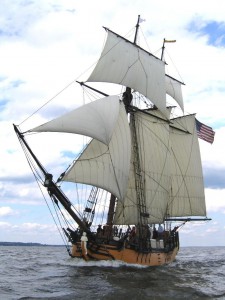
This ship is an exact reproduction of a vessel made in Boston in 1768 as a coastal cargo ship. Purchased by the British, it patrolled the Chesapeake Bay region and visited Mount Vernon. By 1772 it was sold by the Royal Navy and returned to private use. The Society’s grant contributed to the construction.
2003
Maryland State Archives
The Society funded the acquisition of the original book of travels by the 6th Lord Baltimore, Frederick Calvert, the last and most controversial Calvert.
2003
Frederick County Landmarks Foundation
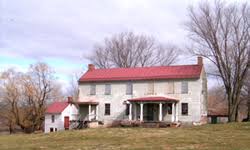
Located in Frederick County, the Beatty-Cramer house is a mid-18th century farmhouse and a rare example of Dutch architecture. As one of the oldest structures in Frederick County, is it considered one of the six most important historic buildings in Maryland. The grant contributed was used to establish an endowment fund for the museum. A later grant helped pay for dendrochronology which determined the construction date as 1748-1752.
2004
Jerusalem Mill
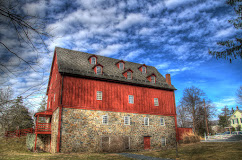
Located in a once Quaker settlement in Baltimore County, this 250 year-old mill and associated blacksmith shop played a vital role in the colonial era. The Society’s grant funded a working model of the original to demonstrate how mills work and how vital they were in early Maryland.
2005
Mount Harmon Plantation
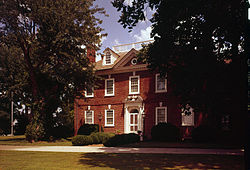
This manor house, constructed in 1730, is in Cecil County and is a good example of Georgian architecture. The Society’s grant was for repointing the exterior.
2006
Brick Chapel, St. Mary’s City
![20476-Chapel[1]](http://www.scwmd.org/wp-content/uploads/2020/03/20476-Chapel1-300x287.jpg)
This is a reconstruction of the 1667 Brick chapel in Maryland’s first settlement and first capital. The English settlers who established it forged what became known as the birthplace of religious freedom in America. Liberty of conscience and separation of church and state were mandated in Maryland far in advance of the laws and practices of other New World colonies. The grant was to support the construction.
2007
Fort Frederick
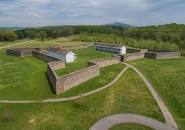
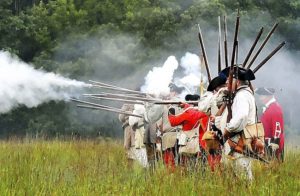
Built in 1756 and named after Frederick Calvert, sixth Lord Baltimore, this was a staging area for troops and supplies during the 1758 campaign to recapture Fort Duquesne from the French. The Society’s grant was used to refurbish the artillery.
2008
Third Haven Meeting House
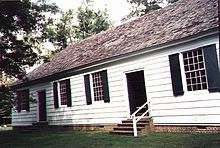
The oldest documented structure in Maryland was built in 1684 in Easton. Still used for worship, the meeting house was visited by William Penn and George Fox, the founder of the Quaker religion. The grant was for restoration.
2009
The George Washington Teachers’ Institute
The goal of the Institute is to instill enthusiasm among teachers for the life and impact of George Washington upon the early years of our country. It runs week-long courses on various aspects of Washington’s influence on who and what we are today.
2010
The Hammond-Harwood House
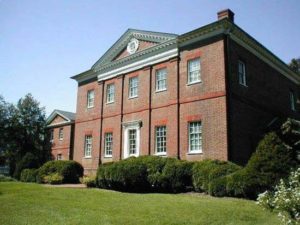
Considered to be one of the finest examples of Georgian architecture in the colonies, the house is a popular museum in Annapolis, sponsoring colonial music recitals, history lectures and related activities. Built in 1774, the Hammond- Harwood House received a grant to help with a major roof restoration.
2011
Archaeological dig at St. Mary’s City, St. Mary’s College
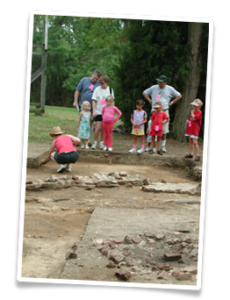
The site of the original 1634 landing of English settlers is recognized by the National Park Service as “probably the most intact 17th century English town surviving in our nation…represented entirely by archaeological resources.” The Society funded the exhibit of relics discovered at the dig and also a permanent exhibit is at the College.
2013
London Town
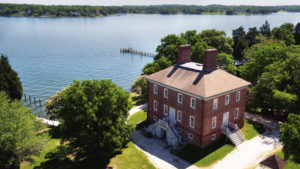
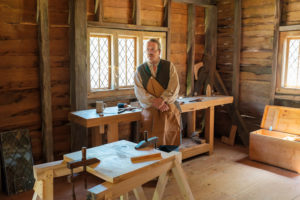
The Publik House is the only remaining structure of a thriving port town established in 1683 on the South River in Annapolis. Over the centuries the house has served as a pub, inn and almshouse. Today the house and grounds serve as a living museum with an 18th century tobacco barn, gardens, and militia. The Society grant was to reconstruct a colonial carpenter’s shop.
2015
Handsell House, Nanticoke Historic Preservation Alliance
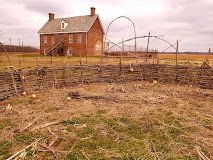
One of the last 18th century brick houses in Dorchester County, it received a grant to reconstruct its fireplaces. The House is adjacent to an older site of a Chicone Indian village, which gives the building particular interest and plays a major role in interpretation.
2016
Gibson Island Historical Society
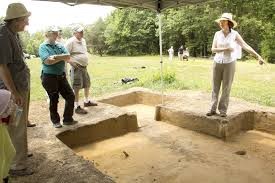
The Society funded exploratory excavations of 18th century sites of the Island. These areas were identified by examining geographical anomalies, and excavations revealed earlier Indian and 17th century relics.
2015
Three Coffins exhibit, St. Mary’s City
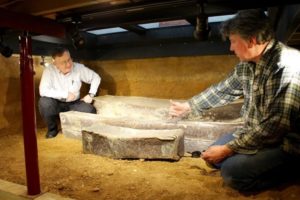
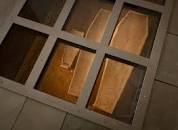
During archaeology around the site of the first Jesuit Chapel, three graves were discovered in the foundation. Found in three lead coffins were the remains of Philip Calvert, son of the first Lord Baltimore, his first wife, Anne Wolseley Calvert and their infant son. The grant funded the exhibit of the three coffins in the reconstructed chapel and the forensic work done by the Smithsonian Institution.
2016
Liberty Tree Crosses
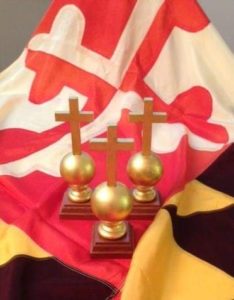
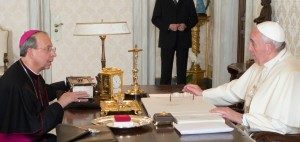
Roots from the Maryland Liberty Tree were donated to the Society by a member and used to make four crosses. The Maryland Liberty Tree was a 600- year-old tulip poplar on St. John’s campus where the Sons of Liberty met before burning the brig Peggy Stewart and her cargo of tea. The crosses were mounted on stands made of oak from the Wye Oak, Maryland’s State Tree. The crosses were designed in a 17th-century Jesuit style that may have adorned the tabernacle of the first church built in Maryland. Created as memorials to Maryland’s history and tradition of practicing freedom of religion, two of the crosses were presented to Pope Francis and Charles, Prince of Wales.
Upon the top of each box containing the cross was inscribed
“THE LIBERTY TREE CROSS MARYLAND FIRST IN FREEDOM OF CONSCIENCE AN ACT CONCERNING RELIGION 1649 PRESENTED TO HIS HOLINESS POPE FRANCIS/HIS ROYAL HIGHNESS THE PRINCE OF WALES BY THE SOCIETY OF COLONIAL WARS IN THE STATE OF MARYLAND 25 MARCH 2015.”
The third cross was presented at a Maryland Day celebration in St. Mary’s City with great ceremony and placed in the tabernacle of the reconstructed brick chapel in Maryland. The fourth cross was presented to Archbishop Lori who placed it in the Basilica’s museum along with a brick from the original brick chapel in St Mary’s City, the first church in Maryland. The crosses are part of the Royal Collection in Great Britain and displayed in the museums of the Vatican, the Baltimore Basilica and Historic St. Mary’s City.
2017
Portrait of a Queen, Maryland State Archives
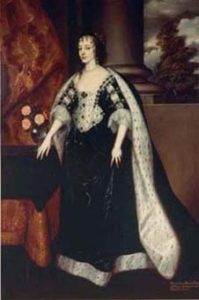
The original portrait of Maryland’s namesake, Henrietta Marie, was painted in the 17th-century by Van Dyke. This 19th-century copy was restored by a grant from the Society. The grant also allowed for her husband, Charles’, portrait to be conserved simultaneously so both were ready for the opening of the 2018 General Assembly.
2018
Fort Frederick
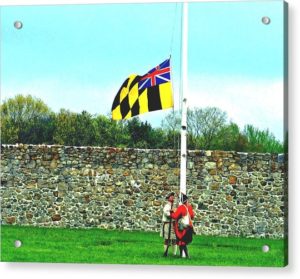
A grant was made to the Friends of Fort Frederick to begin a campaign to erect a historically correct flagpole tall enough to display an exact replica of Governor Sharpe’s flag, commissioned in 1775. At that time, it was described as “a Black and Yellow Flagg 24 feet long and 16 feet broad with the Union in One Corner”.
2019
Rich Hill, Charles County
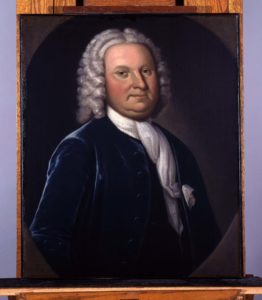
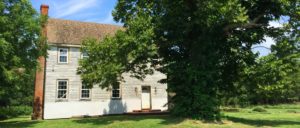
Rich Hill is an 18th century house with a long and multifaceted history, a part of which is associated with John Wilkes Booth. However, the origins of the house are with the Gustavus Brown family of Charles County. The Friends of Rich Hill (associated with the Charles County Historical Society) was established to preserve, refurbish, and promote this unique part of Southern Maryland’s history. One aspect of that project will be the creation of the “Dr. Gustavus Brown Room.” Dr. Brown was the builder of Rich Hill. He came to Maryland in 1708 from Scotland. During the next half century, he became a significant property owner and his children married into the most prominent families of the colony. By the time of his death in 1762, he had also become the Laird of Mainside and House Byres, Roxburg, Scotland. According to the Friends of Rich Hill, Dr. Brown attained “a social position and wealth unparalleled in the colony.” The Society’s contribution funded a room that explained the colonial era of the house’s history and that of the Brown family.
2019
Fort Tonoloway, Washington County
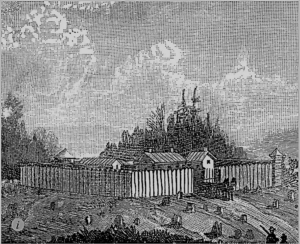
In the summer of 1755, Fort Tonoloway was built quickly by the remnants of General Edward Braddock’s forces following the disastrous attempt to capture Fort Duquesne from the French. It was a heavy timber stockade guarded by twenty men under the command of Lieutenant Thomas Stoddard. During 1756-1757 it was the forward position protecting the construction of the much more substantial Fort Frederick from attack. It was reported that west of Fort Tonoloway houses were burned, livestock slaughtered, and people massacred. After Fort Frederick was completed Fort Tonoloway was abandoned. As part of its “Six-to-Fix” program, Preservation Maryland is partnering with the Maryland Park Service and the National Park Service’s American Battlefield Protection Program to confirm the location of the fort on a parcel of land owned by the State of Maryland. The Society of Colonial Wars in the State of Maryland is recognized on the Preservation Maryland website as another partner in this important endeavor to find a lost part of colonial history. Our grant was for the archaeology to establish the exact location of Fort Tonoloway.
2021
Four Signers Exhibit
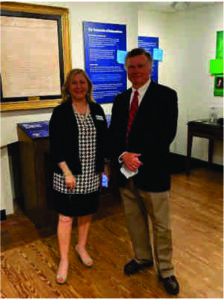

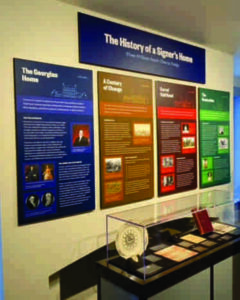
Maryland is unique in that the houses used by all four signers of the Declaration of Independence are still in use today. A joint project funded by the General Society and the Maryland Society created an exhibit that provides a guide to the background and lives of the four signers: William Paca, Charles Carroll of Carrollton, Thomas Stone, and Samuel Chase. Using text, photos, graphics and artifacts, the exhibit relates the issues, lifestyles and personalities of these patriots as well as the events leading up to the Declaration of Independence.
Located in two rooms of the Paca House, about 60,000 people will be able to view the exhibit every year.
2021
St. Clements Manor Dig
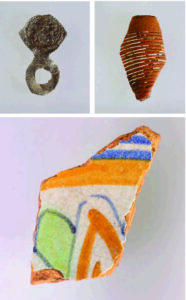
This is one of the two colonial sites located outside of the capital at St. Mary’s City dating to the first decade of settlement (pre-1644). Located on private property, the owner cooperated with Saint Mary’s College of Maryland (SMCM) archaeologists to uncover information about the original manor house; an earth fast building with brick and daub chimneys, all of which was enclosed in a palisade.
Beyond the palisade they uncovered Native made artifacts; trade pipes, arrowheads, glass beads and cut copper objects. These discoveries provide extensive information about the interaction between the original colonists and their Native neighbors.
Julia King, director of the project for SMCM, finished her report on the dig: “SMCM thanks the Society of Colonial Wars in the State of Maryland and the General Society for their generous support of this effort”.

